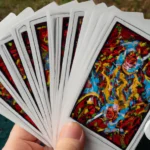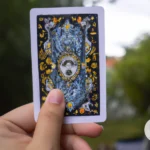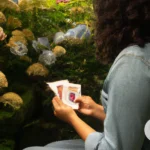As humans, we all have a past filled with experiences that have shaped us into who we are today. Unfortunately, some of these experiences may have left deep-rooted traumas within us. Trauma can cause emotional pain and manifest in physical and mental ways. It can be overwhelming to confront these traumas, but it’s essential for healing and growth. Tarot and Oracle cards have been used as therapeutic tools for centuries, helping individuals gain insight, understanding, and self-reflection. Additionally, they can serve as a path towards healing past traumas. In this article, we will explore how using Tarot and Oracle cards can help confront and heal past traumas step-by-step. We will discuss what Tarot and Oracle cards are, their power as therapeutic tools, and how to use them to identify trauma triggers, work through the trauma, and connect with inner strength and resilience. We’ll also cover how Tarot and Oracle cards can be used for continued healing and growth.
What are Tarot and Oracle Cards?
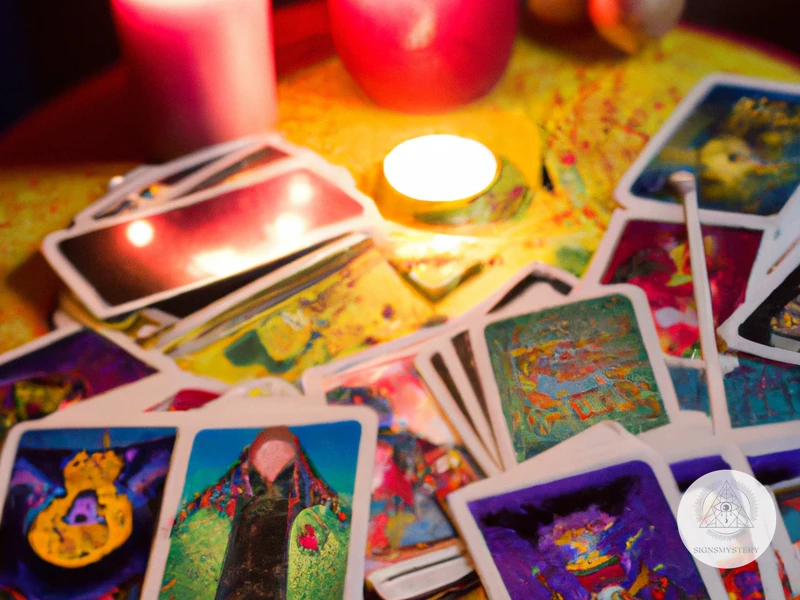
For many, tarot and oracle cards may seem like mysterious tools used for fortune-telling or divination. However, their uses go far beyond predicting the future. Tarot and oracle cards can serve as instruments of self-reflection, growth, and healing. These cards are essentially decks of cards illustrating symbolic images and words that can help people delve into their subconscious and confront their past trauma. Tarot cards are particularly well-known for their ability to uncover an individual’s inner shadows and can be used as a form of Jungian shadow work. In this section, we’ll explore what tarot and oracle cards are and how they can be used beyond the realm of mysticism and divination.
Tarot Cards
Tarot cards, a deck of 78 cards, are often associated with divination and fortune-telling. However, they can also be powerful tools for self-discovery and healing. Each card in the deck represents a different aspect of the human experience, from our deepest fears and desires to our greatest strengths and aspirations.
The Tarot deck is divided into two parts, the Major Arcana and the Minor Arcana. The Major Arcana comprises 22 cards, each with a specific archetype or universal theme, such as the “Shadow” or the “Fool”. The Minor Arcana, on the other hand, consists of 56 cards, divided into four suits: Cups, Swords, Wands, and Pentacles. The Minor Arcana depicts everyday experiences and emotions, such as love, conflict, creativity, and material success.
The Tarot can be particularly useful for confronting and healing past traumas. By working with the symbols and archetypes of the Tarot, we can delve deeply into our subconscious and gain insights into our patterns of behavior and beliefs. We can also identify areas where we may be stuck or feel disempowered, and uncover hidden strengths and resources within ourselves.
For example, Tarot cards can be used for self-reflection and growth, by exploring questions such as: What is blocking me from reaching my goals? What are my deepest fears? What do I need to let go of to move forward? The Tarot can also be used in shadow work, a form of therapy that involves confronting and integrating aspects of ourselves that we may reject or deny. By working with the darker elements of the Tarot, such as the “Shadow” archetype, we can confront our deepest wounds and begin the process of transformation and healing.
It is important to note that Tarot cards should never be used in place of professional therapy. However, they can be a useful adjunct to therapy, or a self-help tool for individuals who are ready and willing to do the inner work. With patience and intention, Tarot cards can help us heal past traumas, connect with our inner strength and resilience, and move towards a more empowered and fulfilling life.
Oracle Cards
Oracle cards are another type of divination tool that can be used for therapy and personal growth. Unlike tarot cards, which have a fixed structure with 78 cards divided into Major and Minor Arcana, oracle cards are much more varied in terms of their format and themes. Some decks may feature affirmations, while others may focus on angels, crystals, animals, or other spiritual concepts.
| Pros | Cons |
|---|---|
| More flexible and customizable than tarot cards, as there are countless themes and styles to choose from | The lack of a fixed structure can make it harder for beginners to interpret the cards |
| Greater focus on positive and uplifting messages, making it a great option for those who may find tarot too intense or intimidating | The lack of a fixed structure can make it easier for personal biases and interpretations to influence the readings |
| Often simpler and more straightforward than tarot cards, making them easier to use for quick readings or daily draws | The lack of depth or complexity in some decks can make it harder to use them for introspection or therapy |
Oracle cards can be a valuable addition to any therapeutic or spiritual practice, as they offer a different perspective and energy than tarot cards. Some popular oracle decks include the Healing with the Angels Oracle Cards by Doreen Virtue, the Wisdom of the Oracle deck by Colette Baron-Reid, and the Mystical Shaman Oracle deck by Alberto Villoldo and Colette Baron-Reid.
Tarot and Oracle Cards as a Therapeutic Tool
When it comes to healing and self-reflection, traditional talk therapy is not the only option. Tarot and oracle cards have long been used as a therapeutic tool to help individuals gain insight and clarity into their emotions, thoughts, and behaviors. Through the power of symbolism and intuition, these cards can unlock deep-seated issues and offer guidance for moving forward. Whether you are dealing with past traumas or simply seeking a greater understanding of yourself, tarot and oracle cards can be a valuable addition to your healing journey. To take your card reading further and explore shadow work, check out our guide on tarot shadow work with the Minor Arcana cards.
The Power of Symbolism
The power of symbolism in tarot and oracle cards lies in the ability of the images to tap into our unconscious mind and evoke emotions and memories that may not be accessible to us otherwise. Each card has multiple layers of meaning, and the symbols on the cards can speak to us in a deeply personal way.
Symbolism allows us to bypass our rational mind and access our intuition and inner wisdom. We may find that certain cards or images jump out at us or resonate with us in a way that we can’t quite explain. These connections can be clues to uncovering underlying issues or emotions that we may not have been aware of before.
Additionally, symbols have universal meanings that can be interpreted in a variety of ways, depending on the context of the reading and the individual’s own experiences and beliefs. For example, the tarot card of the Tower may symbolize upheaval and change for one person, while another may see it as a symbol of necessary destruction before rebuilding.
The power of symbolism lies in its ability to connect us to our subconscious and help us understand and process complex emotions and experiences. When used in a therapeutic context, tarot and oracle cards can be a powerful tool for uncovering and healing past traumas.
To learn more about using tarot cards to explore our inner shadows, check out our guide on tarot and Jungian shadow work. And for a tarot spread specifically designed for shadow work, check out our shadow work spread tarot reading guide.
The Role of Intuition
Intuition plays a significant role in using Tarot and Oracle cards for therapeutic purposes. It allows the reader to tap into their subconscious and discover insights that might not be apparent through conscious thought.
Trusting your intuition is a vital step in the process. Instead of relying solely on logic and analytical thinking, it’s important to let your inner voice take over. This can be challenging for some, especially those who are used to being in control or have difficulty accessing their emotions. However, with practice and patience, anyone can learn to trust their intuition and use it to their advantage.
One tip for developing your intuition is to quiet the mind. Take a few deep breaths, meditate, or simply relax before starting a Tarot or Oracle card reading. This helps to clear any distractions or preconceived notions from the mind and create a receptive state.
Active imagination is also a useful tool in using intuition during a reading. Allow your mind to wander and imagine the potential meanings behind the cards. This helps to access your innermost feelings and connect with your intuition on a deep level.
Finally, keep a record of your readings and interpretations. Over time, patterns may emerge, and you can use this information to further develop your intuition and deepen your understanding of yourself.
Using intuition in conjunction with Tarot and Oracle cards can be an effective way to uncover past traumas and begin the healing process. For those interested in delving deeper into this topic, exploring Tarot and Jungian Shadow Work can provide additional insights and techniques.
Tarot and Oracle Cards as Self-Reflection
The Power of Self-Reflection with Tarot and Oracle Cards
Tarot and oracle cards have the unique ability to act as a mirror, reflecting back our innermost thoughts, feelings, and experiences. By using these cards as a tool for self-reflection, we gain insight into our subconscious mind and can better understand the patterns and behaviors that may be holding us back or causing us pain.
The Benefit of Self-Reflection
Self-reflection is an important tool for personal growth and development. When we take the time to reflect on our thoughts and actions, we can gain a deeper understanding of ourselves and the world around us. This understanding can lead to greater self-awareness and increased compassion, both for ourselves and for others.
Using Tarot and Oracle Cards for Self-Reflection
One of the most powerful ways to use tarot and oracle cards for self-reflection is through daily or weekly card pulls. By selecting a card or cards at random, we can tap into our intuition and gain insight into what we may need to focus on or work through at that particular time.
Another method for self-reflection with tarot and oracle cards is through a personal spread. Creating a spread that is tailored to your unique situation and needs can be a powerful way to gain insight and understanding.
When using tarot and oracle cards for self-reflection, it is important to approach the process with an open mind and a willingness to be honest with oneself. The cards may reveal uncomfortable truths or challenges, but by facing these truths, we can begin to work through them and ultimately grow and heal.
Important Considerations
It is important to remember that tarot and oracle cards are not a substitute for professional therapy or medical treatment. If you are struggling with past traumas or mental health concerns, it is important to seek the appropriate help from a licensed professional.
Additionally, self-reflection can be a powerful but emotionally challenging process. It is important to approach the process with self-compassion and to take breaks as needed.
Using tarot and oracle cards for self-reflection can be a powerful tool for personal growth and development. By tapping into our intuition and gaining insight into our innermost thoughts and feelings, we can begin to work through past traumas, heal, and ultimately live a more fulfilling life.
Using Tarot and Oracle Cards to Confront Trauma
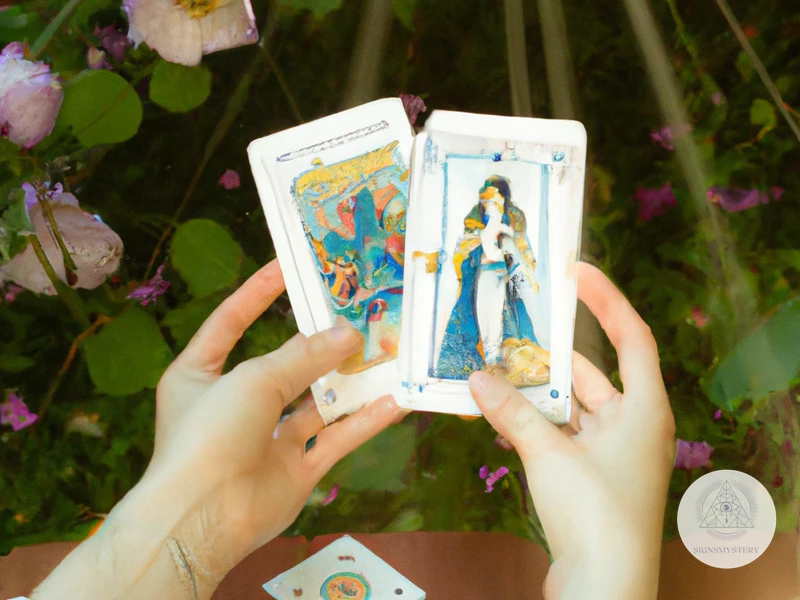
It can be overwhelming to confront past traumas, but using Tarot and Oracle Cards as a therapeutic tool can provide a safe and empowering space to work through difficult emotions. Before diving in, it’s important to choose the right deck and create a safe environment for self-reflection. Starting small and interpreting the cards with intention can lead to important breakthroughs in healing and growth.
Choosing the Right Deck
When it comes to choosing the right tarot or oracle deck for working through trauma, there are several factors to consider. Firstly, it’s important to choose a deck that resonates with you personally. Secondly, you need to look for a deck that has a positive and uplifting energy. Thirdly, you should look for a deck that provides clear and easy-to-understand interpretations.
One way to help you choose the right deck is to research different decks online or in a bookstore. Look at the artwork and read through the interpretations to get a sense of how well the deck will work for you.
Another helpful technique is to visit a spiritual or metaphysical shop where you can handle and examine different decks in person. This will give you a sense of the energy of the deck and how it feels in your hands.
You may also want to consider whether you prefer tarot cards or oracle cards. While tarot cards have a specific structure and set of traditional interpretations, oracle cards tend to be more intuitive and may work better for some individuals.
Ultimately, the deck you choose should feel like a comfortable partner in your healing journey. Don’t be afraid to look at and handle several different decks before making your final decision.
Creating a Safe Space
When using tarot and oracle cards to confront past traumas, creating a safe space is essential to ensure that the process is both effective and healing. Here are some steps to create a safe space:
| Step 1: | Choose a quiet and comfortable space where you feel at ease and secure. This can be a cozy corner of your home, a peaceful park, or any other place where you feel safe. |
| Step 2: | Set the mood by dimming the lights, lighting candles, or playing soft music. Make sure the temperature is comfortable, and that you are wearing comfortable clothing that allows you to relax. |
| Step 3: | Take a few deep breaths and center yourself. You might want to use some grounding techniques, such as feeling the weight of your body on the chair or the ground, or focusing on an object in the room. |
| Step 4: | Visualize a protective circle around you, or use any other visualization that makes you feel safe and secure. You can also call upon your spiritual guides or higher power to protect and support you during the session. |
| Step 5: | Set boundaries for yourself and the session. This might involve setting a timeframe, deciding what topics you will and will not explore, or establishing guidelines for communication and feedback. |
| Step 6: | Have some grounding tools on hand, such as a soothing aromatherapy oil, a comforting blanket or pillow, or a warm cup of tea. These can help you stay connected to the present moment and feel more calm and centered. |
Remember that creating a safe space is not a one-time event, but an ongoing process. You may need to modify your space or your boundaries based on how you feel during the session or in future sessions. It’s also important to be gentle with yourself and to listen to your body and your intuition as you work through past traumas using tarot and oracle cards.
Starting with Small Steps
One of the most important things to remember when using tarot or oracle cards as a therapeutic tool to confront past traumas is to start with small steps. It can be overwhelming to dive headfirst into deep emotional work, so taking things one step at a time is essential for progressing at a comfortable pace. Here are some tips for starting small:
- Begin with a simple spread: Instead of jumping into a complex tarot spread, start with a simple three-card spread. This can help ease you into the practice and give you a basic understanding of how to interpret the cards.
- Use a trustworthy deck: Make sure the deck you choose feels safe and trustworthy to you. Choose a deck that resonates with you on a personal level, and make sure the images and messages feel supportive rather than triggering.
- Set an intention: Before beginning your reading, set an intention for what you want to explore. This can help focus your energy and give you a sense of purpose. For example, your intention might be to gain clarity on a current challenge or to connect with your inner wisdom.
- Take breaks: It’s important to give yourself time to process the information that comes up during your reading. If you feel overwhelmed or triggered, take a break from the cards and engage in some self-care. This can be as simple as taking a few deep breaths or going for a walk.
- Journal about your experience: Writing can be a powerful tool for processing emotions and gaining insights. After your reading, take some time to write down your thoughts and feelings about the experience. This can help solidify your understanding of the messages you received and give you a sense of closure.
Remember, healing from past traumas is a process that takes time and patience. Starting with small steps can help make the process feel more manageable and allow you to move forward at a pace that feels comfortable for you.
Interpreting the Cards
Once you’ve chosen the right deck and created a safe space, it’s time to start your card reading. Interpreting the cards is a key part of using tarot or oracle cards for confronting and healing past traumas. This process involves understanding the images, symbols, and messages on each card.
Here are some tips for interpreting the cards:
| 1. Tune into your intuition: | Don’t overthink the meaning of the cards. Instead, trust your instincts and allow your intuition to guide you. Pay attention to your initial reactions and feelings when you see each card. |
| 2. Consider the symbolism: | Each card is filled with its own unique symbolism. Take a moment to observe the details on each card, such as the colors, animals, and objects. Consider what each of these components could represent. |
| 3. Use a guidebook: | If you’re just starting out, it can be helpful to use a guidebook that explains the meanings of each card. Look for a guidebook that resonates with you and your goals for healing. |
| 4. Apply the cards to your situation: | Take the meanings of each card and apply them to your own life and experiences. Consider how each card relates to your trauma and what message it may be trying to convey. |
| 5. Don’t be afraid to pull more cards: | If a card isn’t making sense or you’re feeling stuck, don’t be afraid to pull additional cards for clarification. Sometimes, a different card or perspective can provide greater insight. |
The most important thing when interpreting the cards is to trust your intuition and allow the cards to guide you on your healing journey. Remember that there is no right or wrong way to read the cards, as they can be interpreted in many different ways. As long as you approach the process with an open mind and heart, the cards can be a powerful tool for confronting and healing past traumas.
Healing Trauma with Tarot and Oracle Cards
As we delve deeper into the therapeutic potential of tarot and oracle cards, one powerful application emerges: using them as a tool for healing trauma. Trauma can live in our bodies and minds long after the initial event, affecting our emotions, behaviors, and relationships. But by connecting with the symbolism and intuition of the cards, we can begin to confront and work through these past wounds. It may feel daunting or uncomfortable to face trauma head-on, but with the right mindset and guidance, tarot and oracle cards can offer a supportive and transformative path to healing.
Identifying Trauma Triggers
When using tarot and oracle cards to confront and heal past traumas, it is important to identify the triggers that cause emotional distress. These triggers can be certain situations, people, or emotions that remind the individual of the traumatic experience. Identifying
Subscribe to Our Newsletter
Sign up to receive the latest news and updates.
- Observe physical reactions: When confronted with situations or people that remind the individual of the trauma, they may experience physical reactions such as increased heart rate, sweating, or trembling. These are physical signs of emotional distress and should not be ignored.
- Explore emotional responses: Experiencing intense emotions such as fear, anger, sadness, or anxiety in response to certain situations may indicate a triggering event. It is important to explore these emotional responses to understand their underlying cause.
- Consider thought patterns: Negative self-talk, self-blame, or catastrophic thinking can also be triggers of past traumas. Recognizing and challenging these thought patterns can help change harmful beliefs and behaviors.
- Reflect on past experiences: Looking back at past experiences and identifying events that caused distress or emotional pain can help determine patterns of behavior and thought that may be related to the trauma.
- Seek professional help: If identifying triggers feels overwhelming or difficult, it may be helpful to seek the guidance of a mental health professional. They can provide support and tools for identifying and coping with triggers.
Identifying trauma triggers is an important step in the healing process. By becoming more self-aware and understanding the root cause of emotional distress, individuals can implement coping mechanisms and work towards a healthier, happier life.
Working Through the Trauma
Working through trauma is a difficult and often painful process, but tarot and oracle cards can be a powerful tool for healing. Here are some steps you can take to use these cards to work through your trauma:
- Take it slow: Start with small, manageable steps when using tarot or oracle cards to work through trauma. Don’t try to rush the process or force yourself to confront things before you’re ready.
- Stay present: When working through trauma with tarot or oracle cards, it’s important to stay present and grounded. Take deep breaths, focus on the physical sensations in your body, and bring your attention back to the present moment as needed.
- Use journaling: Writing down your thoughts and feelings can be a powerful way to work through trauma with tarot or oracle cards. After you’ve drawn a card, take some time to write down your interpretation and any insights or memories that come up.
- Work with a therapist: If you’re struggling to work through your trauma on your own, consider working with a therapist or counselor who can provide guidance and support.
- Be gentle with yourself: Healing from trauma is a long process, and it’s important to be patient and compassionate with yourself as you work through it. Don’t push yourself too hard, and take breaks or step away from the cards if you need to.
- Trust the process: Remember that tarot and oracle cards can be a powerful tool for healing, but they’re not a magic fix. Trust the process and be open to what comes up, even if it’s difficult or painful.
By following these steps and continuing to use tarot and oracle cards as a tool for healing, you can begin to work through your trauma and find greater peace and resilience in your life.
Connecting with Inner Strength and Resilience
When working through past traumas with Tarot and Oracle cards, it’s important to not only confront the pain and hurt caused by the experience, but also to connect with our inner strength and resilience. This can be an empowering and healing experience that helps us move forward with newfound confidence and clarity.
Recognizing Our Strengths: Through the use of Tarot cards, we can begin to identify the strengths and qualities within ourselves that have helped us overcome challenges in the past. This can include resilience, determination, and a deep sense of empathy. By acknowledging and celebrating these strengths, we can build a stronger sense of self-awareness and self-worth.
Connecting to Our Inner Child: Many of us carry trauma and pain from experiences that occurred during childhood. By using Tarot or Oracle cards to connect with our inner child, we can begin to heal those wounds and cultivate a greater sense of self-compassion. This approach can help us access a deeper level of empathy and understanding towards ourselves, allowing us to better navigate challenging emotions and experiences.
Building Confidence: As we work through past traumas and connect with our inner strength and resilience, we may find ourselves feeling more confident and assertive in our day-to-day lives. This newfound confidence can help us set boundaries, communicate more effectively, and tackle challenges with greater ease.
Making Positive Changes: The process of healing and growth often involves making positive changes in our lives. With the guidance of Tarot and Oracle cards, we can gain a deeper understanding of what changes are needed and how we can best implement them. The cards can offer insight and guidance, helping us to make more informed and considered decisions.
Connecting with our inner strength and resilience is a key part of the healing process when working through past traumas. Through this process, we can build greater compassion and self-awareness, while also setting the stage for continued growth and personal development.
Using Tarot and Oracle Cards for Continued Healing and Growth
After confronting past traumas with the help of tarot and oracle cards, the healing process does not have to come to an end. In fact, using tarot and oracle cards can become a regular part of one’s self-care routine for continued healing and growth. Through consistent practice, self-awareness and compassion can be cultivated, allowing for a deeper understanding of oneself and the world around us. In this section, we will explore how to use tarot and oracle cards for long-term healing and personal development.
Practicing Regularly
Regular practice is key to deepening your understanding of Tarot and Oracle cards and to unlocking their full potential as a therapeutic tool. When you practice regularly, you develop a stronger bond with your cards and become more attuned to their energies, which allows you to access their intuitive guidance more easily.
How often should you practice?
There is no right or wrong answer to this question, as the frequency of your practice will depend on your individual needs and preferences. Some people find that practicing once a week is enough, while others may prefer to practice daily.
What should you focus on during practice?
During your practice sessions, you may choose to focus on different aspects of Tarot and Oracle card reading. For example, you might choose to practice shuffling the cards, asking specific questions, or interpreting card meanings. You may also choose to incorporate other mindfulness practices such as meditation, journaling, or breathwork to enhance your practice and deepen your introspection.
What are the benefits of regular practice?
There are many benefits to practicing Tarot and Oracle card reading regularly. Some of these include:
- Increased intuition and insight
- Greater self-awareness
- Enhanced ability to navigate challenges and obstacles
- Deeper understanding of personal patterns and behaviors
- Increase in overall well-being and sense of peace
How can you make regular practice a habit?
In order to make regular practice of Tarot and Oracle cards a habit, it can be helpful to set a regular time and place for your practice sessions. You may also find it helpful to keep a journal of your readings or to track your progress in some other way, such as with a progress chart or milestone tracker. Additionally, setting specific intentions or goals for your practice can help to increase your motivation and focus. Remember to be patient and gentle with yourself as you develop your practice, and to honor your own individual needs and preferences along the way.
Building Self-Awareness and Compassion
Strengthening self-awareness and compassion are essential aspects of using tarot and oracle cards as a therapeutic tool for confronting and healing past traumas. By reflecting on the symbolism and messages of the cards, individuals can gain insights into their emotions, behaviors, and thought patterns. This newfound awareness can then be used to cultivate greater self-compassion and understanding.
One way to build self-awareness is to regularly journal about the cards pulled during a tarot or oracle card reading. Writing down thoughts, feelings, and observations can help individuals better understand their inner world and identify patterns that may be contributing to their trauma. Additionally, using keywords or phrases associated with the cards can help individuals identify recurring themes or areas of focus.
In order to cultivate self-compassion, it can be helpful to approach the cards with a curious and non-judgmental mindset. Rather than becoming frustrated or discouraged by challenging cards, individuals can view them as opportunities for growth and learning. Practicing self-compassion means recognizing that everyone experiences pain and suffering, and that it is okay to be gentle with oneself. This can be especially important when working through past traumas, which may be deeply painful and difficult to confront.
Finally, building self-awareness and compassion can also involve seeking out additional resources and support. This may include working with a therapist, joining a trauma support group, or seeking out books or articles on trauma and healing. By supplementing tarot and oracle card readings with other sources of information and support, individuals can deepen their understanding of themselves and their experiences.
Building self-awareness and compassion through the use of tarot and oracle cards can be a powerful way to promote healing and growth. By approaching the cards with an open mind and gentle spirit, individuals can gain deeper insights into their trauma and develop greater self-compassion and understanding.
Setting Intentions for Healing and Growth
As you continue to use tarot and oracle cards for healing and growth, it’s important to set clear intentions for each session. This will help you stay focused and open to the messages the cards have for you. Here are some steps to follow when setting your intentions:
- Be specific: Think about what you want to focus on in your session. It could be a particular trauma or issue you’re working through, or a general desire for growth and self-discovery.
- Phrase your intention positively: Instead of saying “I don’t want to feel anxious anymore,” try saying “I am open to discovering new ways to experience calm and relaxation.”
- Visualize: Take a few moments to picture yourself achieving your intention. This will help you connect with the energy of what you’re hoping to manifest.
- Write it down: Putting your intention into words can help solidify it in your mind. You could write it in a journal, or simply repeat it to yourself a few times before beginning your session.
Remember that your intentions can change from session to session, and it’s okay to be flexible. The important thing is to approach each session with an open mind and a willingness to learn and grow. By setting clear intentions, you’ll be able to focus your energy and attention on the areas of your life that need the most healing and growth.
Conclusion
In conclusion, it is important to recognize that utilizing tarot and oracle cards as a therapeutic tool to confront and heal past traumas is a process that requires patience, self-awareness, and self-compassion. By choosing the right deck and creating a safe space, individuals can begin to work through their trauma and connect with their inner strength and resilience.
Through careful interpretation of the cards and practicing regularly, individuals can continue to build their self-awareness and compassion towards themselves and others. By setting intentions for healing and growth, individuals can actively work towards a brighter and more fulfilling future.
It is important to remember that tarot and oracle cards do not provide all the answers and are not a substitute for therapy or medical care. However, they offer a unique and powerful tool for self-reflection and growth.
Whether used alone or in combination with other therapeutic methods, tarot and oracle cards can provide a safe and empowering space for individuals to confront their past traumas and embark on a journey towards healing and growth. With patience, commitment, and self-compassion, individuals can use these cards as a powerful catalyst for transformation and holistic healing.
Frequently Asked Questions
Can Tarot and Oracle Cards really help with traumatic experiences?
Yes, Tarot and Oracle Cards can be powerful tools for self-reflection and healing, especially when used in conjunction with therapy.
Do you need to be experienced with Tarot or Oracle Cards to use them for healing?
No, anyone can use Tarot and Oracle Cards for healing, regardless of their level of experience. It’s important to choose a deck that resonates with you and to approach the practice with an open mind.
Can Tarot and Oracle Cards be used as a substitute for therapy?
No, Tarot and Oracle Cards should not be used as a substitute for therapy, but rather as a complementary tool. It’s important to seek professional help if you’re struggling with past traumas.
Are there any risks to using Tarot and Oracle Cards for trauma healing?
Working through past traumas can be an emotional and intense experience, so it’s important to create a safe space for yourself and to seek support if needed. That being said, Tarot and Oracle Cards themselves do not pose any risks.
What should I look for when choosing a Tarot or Oracle Card deck?
Choose a deck that speaks to you and that you feel drawn to. Look for decks with artwork or themes that resonate with your personal journey and healing process.
How do I interpret Tarot and Oracle Cards?
There are many resources available on how to interpret Tarot and Oracle Cards, including books, online guides, and workshops. It’s important to trust your intuition and to explore the symbolism of the cards in relation to your personal experiences.
Can Tarot and Oracle Cards provide insight into my future?
While Tarot and Oracle Cards can provide guidance and insights, they should not be used as a tool for predicting the future or making major life decisions.
What benefits can I expect from using Tarot and Oracle Cards for healing?
Working with Tarot and Oracle Cards can help you develop self-awareness, gain insight into your emotions and past experiences, and connect with your inner strength and resilience.
How often should I practice using Tarot and Oracle Cards for healing?
There is no set frequency for using Tarot and Oracle Cards for healing, but incorporating the practice into your self-care routine can be beneficial. Start with small steps and listen to your intuition about when and how often to practice.
Can Tarot and Oracle Cards be used in group therapy sessions?
Yes, Tarot and Oracle Cards can be used in group therapy sessions as a tool for self-reflection and sharing experiences. However, it’s important for the therapist to provide guidance and create a safe space for all participants.





